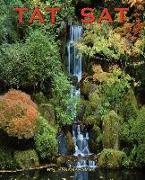- Start
- Tat SAT
Tat SAT
Angebote / Angebote:
TAT SAT
The Brahman, the Supreme Being, is referred to by three words OM, Tat and Sat. The Brahman is the ultimate reality. It is pure consciousness devoid of all attributes (nirguna) and all categories of the intellect (nirvisesa). Being associated with Its potency (Maya), The Brahman appears as the qualified one, Saguna Brahman, or the Lord (Iswara) who is the Creator, Preserver or Destroyer of the world which is nothing, but His appearance. It is thus, because of Maya, the Brahman is said to be the Creator of the world.
Maya is not pure illusion. It is not only absence of knowledge, but also positive wrong knowledge and is, therefore, Bhavarupa (of positive nature). It is indescribable. It is neither existent nor non-existent, nor both. It is not existent for the Brahman alone is the existent (sat). It is not non-existent for it is responsible for the appearance of the world. It cannot be both existent and non-existent as such a statement is self-contradictory. It is thus neither real nor unreal, it is Mithya, but is not a non-entity like the horn of a hare. A rope is mistaken as a snake. The rope is the ground on which the snake is super-imposed. When right knowledge arises, this error vanishes. The relation between the rope and the snake is neither that of identity nor of difference, nor of both. It is unique and known as non-difference (tadatmya). Similarly, the Brahman is the ground on which the world appears through the power, Maya. When right knowledge dawns, the real nature of the so-called Jiva is realized, and Maya vanishes.
Tat Sat is a book detailing Advaita Vedanta - the mainstay of the Indian Philosophy, in its intricacies. It forms part of the rich content of Vedic literature in English on the World Wide Web portal Sri Sathya Sai Veda Pratishtan at www.vedamu.org.
About the Author
K.R. Paramahamsa was a retired civil servant in India borne on the Indian Administrative Service. He has created the website Sri Sathya Sai Veda Pratishtan at www.vedamu.org , a repository of all the Vedic literature available in India in Devanagari and Grantha scripts. Besides, the website hosts 415 hours of Vedic chanting of ten Veda sakhas in different modes in a representative way. He is Adjunct Faculty of the Hindu University of America in Florida. He is now a resident of the Ashram of Bhagavan Sri Sathya Sai at Prasanthi Nilayam-515134, India in pursuit of spiritual upliftment.
Table of Contents
Prologue
1. Enquiry
2. Cosmos
3. Physical Matter
4. Non-physical Categories
5. Cognition
6. Metaphysics of the Cosmos
7. Metaphysics of Human Beings
8. Reality
9. Truth
10. Quest for Realization
11. Basic Thoughts of the Upanishads
12. Atman
13. The Brahman
14. Being - Being
15. Becoming
16. Relative World
17. Consciousness
18. Realization - Bliss
19. The Path of Ethical Action
20. The Path of Devotion
21. The Path of Yoga
22. The Path of Discrimination and Knowledge
23. Non-Dualism
Appendix
About Us
Glossary of Important Sanskrit Words
Folgt in ca. 5 Arbeitstagen
